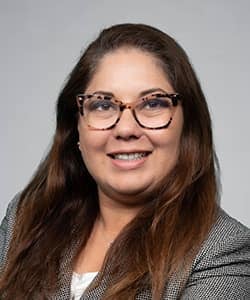Female Leaders in Interventional Cancer Pain Management
Cite as: Streid J, Ori A. Female leaders in interventional cancer pain management. ASRA Pain Medicine News 2025;50. https://doi.org/10.52211/asra080125.004.
Interventional cancer pain is an ever-growing field, increasingly seen as a necessary component of comprehensive oncologic care. The discipline encompasses every stage of cancer care, including early symptom management, pain control at the end of life, and longitudinal care for survivors. Interventional procedures are similarly varied, ranging from epidural steroid injections to alleviate pain from bony metastases to intrathecal drug delivery in the setting of disease progression.
Female pain physicians have been instrumental in advancing interventional chronic pain. Pain medicine as a whole suffers from a nationwide gender gap. As of 2022 data, only 19.8% of pain physicians are female.1 Moreover, in the 2022-2023 academic year, women represented only 23.4% of pain medicine fellows,2 meaning the pipeline to pain medicine mirrors the gender disparities of the field itself. Gender disparities persist at all levels, from society leadership to industry partnership to academic research.
This article highlights the contributions of some of the well-known female physician leaders in interventional cancer pain. Their example inspires all women pain physicians who are seeking to enter what is still a male-dominated field.
No discussion of cancer pain management is complete without Dr. Lisa Stearns. Sometimes described as the mother of cancer pain, Dr. Stearns is one of the founders of the field. She was dedicated to addressing uncontrolled pain for patients with life-limiting illnesses. In Anesthesia & Analgesia, she wrote that “Cancer pain management requires the clinician to wear many hats—pain doctor, counselor, functional monitor, nutritionist, end of life counselor, and friend.”3 Sometimes referred to as the “Pump Queen”,4 her research demonstrated that intrathecal drug delivery could provide meaningful pain control, improve quality of life, and decrease healthcare utilization for patients with cancer.5-7 Among many roles, she served as a founding board member of the Cancer Pain Research Consortium (CPRC), an international organization of physicians devoted to cancer pain. She was also a founding member of Women in Neuromodulation (WIN), where she fiercely advocated for mentorship in pain medicine.4 In 2020, a month before her passing, she was selected as a recipient of the American Society of Pain and Neuroscience (ASPN) Cancer Pain Physician of the Decade. Since her death, the North American Neuromodulation Society (NANS) and WIN have awarded an annual Lisa Stearns Award to cancer pain physicians. Dr. Stearns was deeply committed to her patients and was known not only for implanting intrathecal pumps but also for visiting patients’ homes to manage these pumps herself when they transitioned to hospice.4
Cancer pain spans all stages of the disease, and as curative treatments improve, an increasing number of patients grapple with symptoms for years after their diagnosis
Dr. Stearns’ legacy continues in the clinicians who have followed in her footsteps. Dr. Sandy Christiansen, Associate professor of anesthesiology at Oregon Health and Science University, received the NANS Lisa Stearns Award in 2022. Dr. Christiansen built the cancer pain program at OHSU from the ground up. Inspired by the patients she cared for during her fellowship at Johns Hopkins, she arrived at OHSU in 2016, committed to creating a cancer pain pathway to provide patients with interventional options. She hired a care coordinator to expedite scheduling for patients with cancer, reducing the wait times to see a pain provider. Dr. Christiansen also invested in relationships across specialties. She introduced a bimonthly multidisciplinary meeting with social work, oncology, acupuncture, and palliative care representatives to develop multimodal patient care plans. Her efforts have turned OHSU into one of the nation’s best interventional cancer pain centers. For Dr. Christensen, improving cancer pain also means improving trainee education. In a study published in Regional Anesthesia and Pain Medicine in June 2024, she and her team conducted a nationwide survey of pain fellows, finding that although performing a procedure during fellowship corresponded closely with comfort offering that procedure after training, the majority of respondents had no experience performing seven out of eight listed procedures for cancer-related pain.8 Her work draws attention to major deficits in procedural training, serving as a call to action for the field. When asked what advice she might have for women in pain medicine, Dr. Christensen told us, “Advocate for yourselves. If you want it, sometimes you have to create it.”
We are also inspired by physician-scientists working at the forefront of cancer pain. Dr. Gina Votta-Velis, Professor at the University of Illinois, told us, “I have always been interested in elucidating mechanisms for the pathophysiology and treatment of pain. I firmly believe that without science, every field in medicine has no future.” Her research has earned national and international awards and ranges from animal model bench research to clinical and translational trials. She is passionate about unlocking the biological underpinnings of pain transmission and perception as a foundation for emerging therapeutics. For example, her work has demonstrated that targeting VEG-F (Vascular Endothelial Growth Factor) receptors may interfere with pain transmission pathways. Dr. Votta-Velis is also exploring the impact regional pain management may have on the attenuation of metastasis and is a recipient of the Carl Koller Memorial Research Grant for her work examining the effect of lidocaine infusions on the behavior of tumor cells. In addition to her research, she is the Program Director for the Pain Medicine Fellowship at the University of Illinois. She also serves on the editorial board of Regional Anesthesia & Pain Medicine. In recognition of her efforts, she received the 2020 ASRA Trailblazer Award.
Cancer pain spans all stages of the disease, and as curative treatments improve, an increasing number of patients grapple with symptoms for years after their diagnosis. Dr. Whitney Luke, medical director of Oncology Rehabilitation at Ohio State, leverages her background in physical medicine and rehabilitation (PMR) to address the longitudinal needs of patients. She told us, “Even those patients who are cured of cancer often continue to have symptoms as a sequelae of their disease and treatments, and working with them to find ways to improve their functional outcomes and quality of life is extremely important.” Thanks to her leadership, the Oncology Rehabilitation program at Ohio State is the second accredited inpatient cancer rehabilitation program in the country and the first in the state. She has also transformed inpatient to outpatient transitions of care. After noticing the appointment burden carried by patients, she designed a survivorship clinic that places PMR, pain medicine, pain psychology, physical therapy, occupational therapy, and survivorship classes in one place, allowing access to multiple specialists on the same day. When we asked Dr. Luke for advice, she might have to women in the field, she explained, “It’s hard to believe that the percentage of females in pain medicine is still as low as it is… Don’t let this deter you! It is hard sometimes still to be one of the only women in the room or meeting, but that often can be a positive and allow you to voice your perspective!”
Dr. Elizabeth Rickerson is dual-trained in pain medicine and palliative care. She has focused her practice on caring for cancer patients at Brigham and Women’s Hospital and the Dana-Farber Cancer Institute. She is the director of the Inpatient Palliative Care Unit (IPCU), which cares for seriously ill patients with acute symptom management needs. The IPCU has been shown to decrease hospital readmissions, aid in clarifying goals of care, and, as a result, improve hospice referrals.9 Dr. Rickerson told us that “there is no better feeling in the world than taking away a cancer patient’s pain.” She has demonstrated that interventional pain management skills work with palliative care expertise to provide uniquely comprehensive care to patients at the end of life. Her academic contributions span from pharmacologic and interventional approaches to end-of-life pain to improving perioperative code status discussions. Known across the institution for her expertise, unfailing warmth, and good humor, she is a role model for interdisciplinary collaboration. Ever the educator and advocate, Dr. Rickerson, told us that her proudest contribution to the field is “training fellows who have gone on to address cancer pain across the country.”
We are inspired and encouraged by the work of female physicians in interventional cancer pain. These innovators are advancing cancer care across all fronts, from basic science research to institutional reform, survivorship rehabilitation, and care at the end of life. Across a diverse range of expertise and experience, all the women we spoke with have demonstrated courage and creativity in building out their vocations. As Dr. Rickerson told us, “Don’t let anyone tell you what you can and can’t do with your career.”


- Total U.S. Physicians in Pain Medicine and Pain Management, Washington, DC: Association of American Medical Colleges. Available at: https://www.aamc.org/data-reports/report/us-physician-workforce-data-dashboard. Accessed June 4, 2024.
- Education ACGME. Data Resource Book, Academic Year 2022-2023. Chicago, IL: Accreditation Council for Graduate Medical Education. https://www.acgme.org/about/publications-and-resources/graduate-medical-education-data-resource-book. Accessed June 4, 2024.
- Stearns LM. In response. Anesth Analg 2020;130(5):e152. https://doi.org/10.1213/ANE.0000000000004675
- Jameson J, Vanterpool S, Anitescu M, et al. Neuromodulation 2020;23(5):553-4. https://doi.org/10.1111/ner.13240
- Stearns LM, Abd-Elsayed A, Perruchoud C, et al. Intrathecal drug delivery systems for cancer pain: an analysis of a prospective, multicenter product surveillance Registry. Anesth Analg Feb 2020;130(2):289-97. https://doi.org/10.1213/ANE.0000000000004425
- Stearns LJ, Narang S, Albright RE, et al. Assessment of health care utilization and cost of targeted drug delivery and conventional medical management vs conventional medical management alone for patients with cancer-related pain. JAMA Netw Open Apr 05 2019;2(4):e191549. https://doi.org/10.1001/jamanetworkopen.2019.1549
- Stearns LJ, Hinnenthal JA, Hammond K, et al. Health services utilization and payments in patients with cancer pain: a comparison of intrathecal drug delivery vs. conventional medical management. Neuromodulation 2016;19(2):196-205. https://doi.org/10.1111/ner.12384
- Woodrow A, Teramoto M, Thapliyal M, et al. Procedural education for cancer-related pain in pain medicine fellowships: a national program survey. Reg Anesth Pain Med 2024;49(6):440-7. https://doi.org/10.1136/rapm-2023-104630
- Zhang H, Barysauskas C, Rickerson E, et al. The intensive palliative care unit: changing outcomes for hospitalized cancer patients in an academic medical center. J Palliat Med 2017;20(3):285-9. https://doi.org/10.1089/jpm.2016.0225